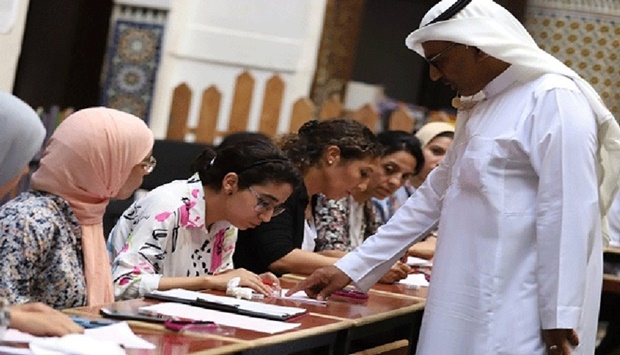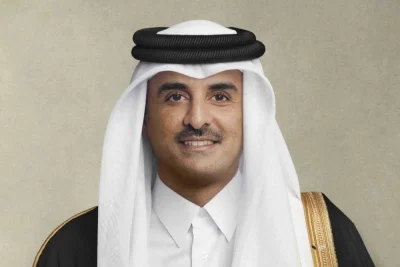Professor of Arabic Arts and Calligraphy and Vice Dean of the Faculty of Education at Umm Al-Qura University in Saudi Arabia, Dr Abdullah Fattini, says that Arabic calligraphy is currently experiencing a state of awakening throughout the Arab world.
The famous Saudi calligrapher Dr Fattini is taking part as an honorary guest of the 7th Fez International Festival of Arabic Calligraphy, currently held in Morocco.
In a special statement to Qatar News Agency (QNA) via a telephone call, Fattini said: "Arabic calligraphy has witnessed a strong start since the year 2020, which Saudi Arabia allocated to be the year of Arabic calligraphy, culminating in the efforts of 16 Arab countries to register on the list of intangible cultural heritage in the list of the UN Educational, Scientific and Cultural Organisation (Unesco), during the meeting of the 16th session of the Intergovernmental Committee for the Safeguarding of the Intangible Cultural Heritage, in December 2021."
He noted that such events, which identify the art of Arabic calligraphy in the Arab countries, including the Fez International Festival of Arabic Calligraphy, contribute to increasing artistic awareness and attention to this heritage, which is considered the course of Islamic arts, in addition to reducing the gap between Arabic calligraphy and its presence in the fields of education, especially early education in the Arab world, in conjunction with the growth and development of technology tools and modern technologies.
Fattini, who holds a PhD degree on "A Critical Study of the Impact of Modern Technology on the Artistic Values in Arabic Calligraphy and its Taste", added that modern technologies from the fact of his study still represent a double-edged weapon; the first is that it served Arabic calligraphy in terms of the rapid spread of computers and the speed of work completion, but on the other hand, the letters in the computer produced by technology, no matter how perfect, lack the human aspect, and it means the artistic sense of the calligrapher, stressing that in his study he examined the possibility of modifying the distorted letters in this device, as the one who designed some fonts did not have sufficient knowledge of the aesthetic values of Arabic calligraphy, as there are letters that are difficult to draw in their multiple aesthetic forms such as the letter M.
He explained that he is participating in the Fez Festival of Arabic Calligraphy, where he presented a workshop in the art of Fatimid Kufic calligraphy, a type of ancient Arabic calligraphy that appeared in the city of Kufa in Iraq in a dry and soft form, the dry or geometric image continued in Kufa and its features changed somewhat with the expansion of the Islamic conquests, so part of it appeared in North Africa, and was called Fatimid Kufic calligraphy, and it has distinctive aesthetic characteristics that were focused on in the workshop, while it acquired other characteristics by moving to Andalusia, so it was called Almoravid Kufic Calligraphy, pointing out that the festival witnessed a great interaction and the participants were able to create paintings at the end of the workshop which lasted three days.
The Fez International Festival of Arabic Calligraphy concludes its activities on Thursday, as it aims to introduce the Fatimid Kufic calligraphy, and discover the aesthetics of Moroccan Kufic calligraphy (Almoravid, Marinid, Alawi).The festival also witnesses workshops in the Moroccan Andalusian calligraphy, Almoravid Kufic calligraphy, the Kufic Qur'anic calligraphy, decoration: the Moroccan style and its forms, as well as workshops to introduce the foundations and principles on which the Moroccan simplified calligraphy is based, the materials and their use in calligraphy, and the design characteristics of inscriptions and writing in Moroccan architecture. (QNA)
The famous Saudi calligrapher Dr Fattini is taking part as an honorary guest of the 7th Fez International Festival of Arabic Calligraphy, currently held in Morocco.
In a special statement to Qatar News Agency (QNA) via a telephone call, Fattini said: "Arabic calligraphy has witnessed a strong start since the year 2020, which Saudi Arabia allocated to be the year of Arabic calligraphy, culminating in the efforts of 16 Arab countries to register on the list of intangible cultural heritage in the list of the UN Educational, Scientific and Cultural Organisation (Unesco), during the meeting of the 16th session of the Intergovernmental Committee for the Safeguarding of the Intangible Cultural Heritage, in December 2021."
He noted that such events, which identify the art of Arabic calligraphy in the Arab countries, including the Fez International Festival of Arabic Calligraphy, contribute to increasing artistic awareness and attention to this heritage, which is considered the course of Islamic arts, in addition to reducing the gap between Arabic calligraphy and its presence in the fields of education, especially early education in the Arab world, in conjunction with the growth and development of technology tools and modern technologies.
Fattini, who holds a PhD degree on "A Critical Study of the Impact of Modern Technology on the Artistic Values in Arabic Calligraphy and its Taste", added that modern technologies from the fact of his study still represent a double-edged weapon; the first is that it served Arabic calligraphy in terms of the rapid spread of computers and the speed of work completion, but on the other hand, the letters in the computer produced by technology, no matter how perfect, lack the human aspect, and it means the artistic sense of the calligrapher, stressing that in his study he examined the possibility of modifying the distorted letters in this device, as the one who designed some fonts did not have sufficient knowledge of the aesthetic values of Arabic calligraphy, as there are letters that are difficult to draw in their multiple aesthetic forms such as the letter M.
He explained that he is participating in the Fez Festival of Arabic Calligraphy, where he presented a workshop in the art of Fatimid Kufic calligraphy, a type of ancient Arabic calligraphy that appeared in the city of Kufa in Iraq in a dry and soft form, the dry or geometric image continued in Kufa and its features changed somewhat with the expansion of the Islamic conquests, so part of it appeared in North Africa, and was called Fatimid Kufic calligraphy, and it has distinctive aesthetic characteristics that were focused on in the workshop, while it acquired other characteristics by moving to Andalusia, so it was called Almoravid Kufic Calligraphy, pointing out that the festival witnessed a great interaction and the participants were able to create paintings at the end of the workshop which lasted three days.
The Fez International Festival of Arabic Calligraphy concludes its activities on Thursday, as it aims to introduce the Fatimid Kufic calligraphy, and discover the aesthetics of Moroccan Kufic calligraphy (Almoravid, Marinid, Alawi).The festival also witnesses workshops in the Moroccan Andalusian calligraphy, Almoravid Kufic calligraphy, the Kufic Qur'anic calligraphy, decoration: the Moroccan style and its forms, as well as workshops to introduce the foundations and principles on which the Moroccan simplified calligraphy is based, the materials and their use in calligraphy, and the design characteristics of inscriptions and writing in Moroccan architecture. (QNA)



